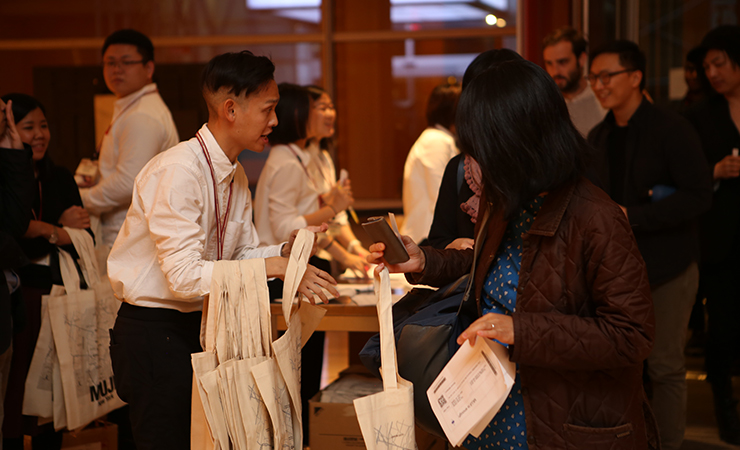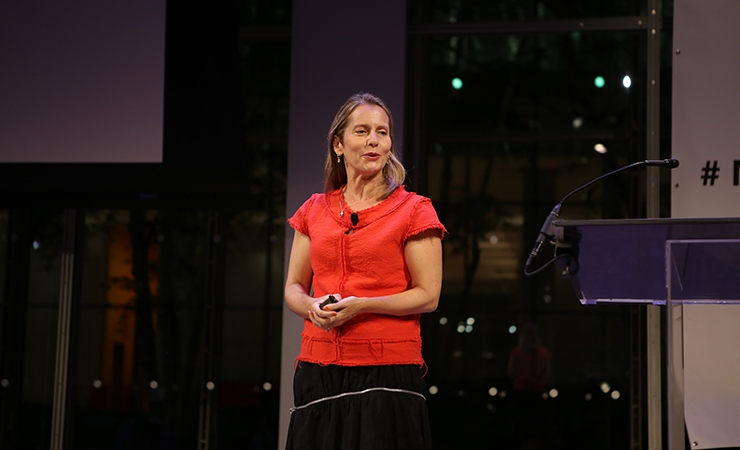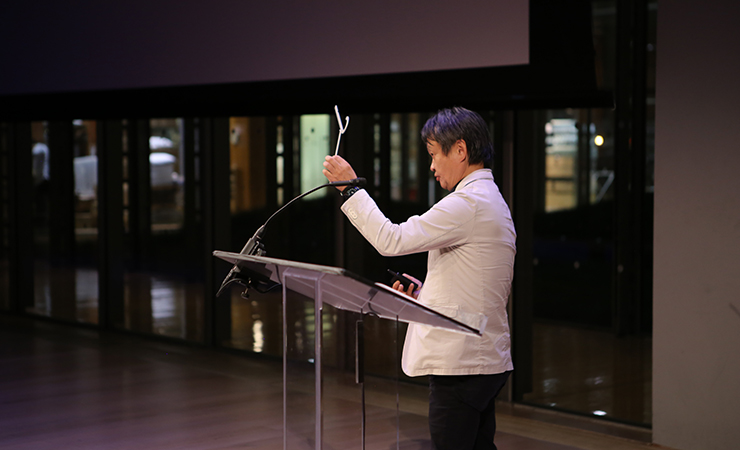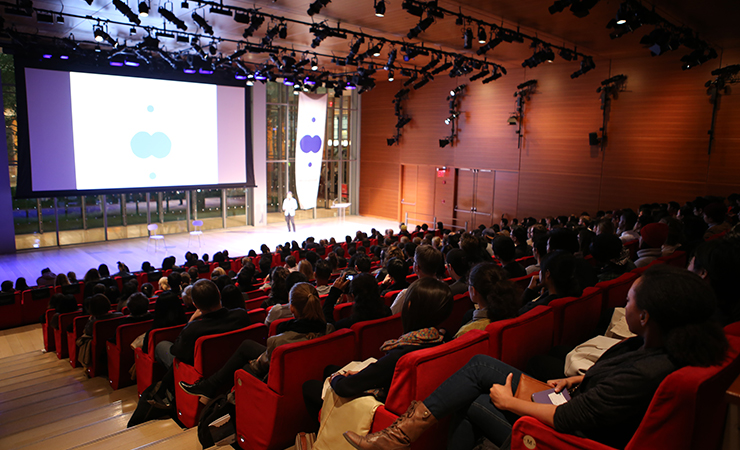Event Report
MUJI is Enough
What is MUJI?
Design enthusiasts gathered at The Times Center to learn more about the Japanese brand and celebrate the opening of MUJI’s new flagship store on Oct. 15, 2015. Slated for a November opening, the MUJI Fifth Avenue will be centrally located on Fifth Avenue and 41st Street, across the street from the New York Public Library in Bryant Park and a stonesthrow from Grand Central Station.

In her opening remarks to the audience, MUJI USA president, Asako Shimazaki explained, “Before we open our flagship store, we’d like you to know more about MUJI.”
Japan in 1980. The name is derived from the words Mujirushi Ryōhin which means, “No brand but Quality Goods.” Beginning with only 40 products focused on food and daily essentials, the current MUJI includes over 7,000 products including furniture, homewares and icons of design like Wall-mounted CD player. In 2007, MUJI opened its first US location in New York City’s SoHo neighborhood. The Fifth on Fifth store, which is MUJI’s fifth store in New York and located on Fifth Avenue, opens in mid-November and will be a showcase for MUJI’s newest innovations. Not only will there be exclusive products like select books and kids clothing, but specialized services on site like customized produsts and personalized embroidery.

The member of MUJI’s advisory board and internationally famous product designer Naoto Fukasawa was the night’s keynote speaker. Paola Antonelli, Senior Curator of the Department of Architecture & Design and Director of R&D at The Museum of Modern Art, provided a brief introduction to Fukasawa’s work. Antonelli and Fukasawa have a friendship that extends back over 20 years to a time when Fukasawa was living in San Francisco working for the pioneering interaction designer Bill Moggridge at ID2—later the design agency IDEO.

In 1996 they worked on their first project together. By that time, Fukasawa had moved back to open the IDEO offices in Tokyo. Antonelli commissioned him to design a product that would reflect the future of work. “I asked Naoto to think about what would happen if you were stuck in your cubicle and Naoto came up with nine different ideas about individuality in the office, two of which became MoMA prototypes.” These two early projects—an OLED screen that projected views of the sky from around the world and a chair that would capture the “soul” of the person seated in it—give a glimpse into Fukasawa’s early design philosophy.
“Our relationship seems inevitable,” Fukasawa explained in his opening. “MUJI and I share a similar design mind.” Fukasawa’s talk was entitled, “MUJI is Enough.” The title might seem strange, but the idea speaks to both the brand and the designer’s philosophy. MUJI strives to create products that consider the details of daily life—even if a customer in search of a specific product doesn’t plan to buy it from MUJI, oftentimes they find that MUJI’s version of the product is “just right.” This idea of just right bestows an appropriate sense of happiness to the customer.
Without Thought(translation)
One example of this approach is MUJI’s Wall-mounted CD player designed by Fukasawa in 2002. “The product is not just an object,” Fukasawa explains. An icon of product design, the coverless CD player is minimal in form but intuitive in action. With a pull of the cord—mimicking the nostalgic pull cord of a vintage kitchen fan—the CD begins to spin and music plays out of the embedded speaker. “The object dissolves in our behavior.” The idea of an object’s functionality dissolving into human behavior is captured in the phrase, Without Thought(translation), and has been explored through a number of design workshops led by Fukasawa and his team. It is built on the idea that our intuitive actions should lead design. Instead of focusing on designing an object for the mind, design an object for the body and what Fukasawa calls, “subconscious behavior.” One example he gives is the design of an umbrella stand. If a person sees a groove in the floor next to a wall, that person would naturally place the tip of an umbrella into the groove and lean the umbrella against the wall. Perhaps, instead of designing an object as an umbrella stand, one would design a recess in the floor. “It’s functionally right,” and a person would interact with the recess without thought. Fukasawa elaborates, “It’s purpose is complete.”
JUST RIGHT
Another tenet of MUJI’s design approach is the idea of creating what is appropriate for everyday life. Just Right is comforting. Just Right is pleasing. An example of this approach is MUJI’s mattress with four legs. “We don’t call it a bed because it is a mattress and we attach legs underneath so we don’t need a bed.” All of MUJI’s products communicate in this straight-forward, minimal and appropriate way.
MUJI also sees its products as a counterbalance to the extremes of culture, a brand that creates harmony with products whose size, fit and materials are appropriate—just right. An extension of the just right philosophy is the idea of a compact life. MUJI’s range of modular and expansive storage options are a great example of this philosophy. No matter what the needs of the customer are, the storage solutions offer objects that can live in the background of one’s life.

RICHNESS IN THE MINIMUM
Daily rituals bring stability and happiness in our lives. The MUJI to Go line of travel accessories underline this fact. Even when taking a break from everyday life, simple rituals can bring happiness. Simplified versions of everyday objects (hangers, beauty products, laundry) can be comforting even when experiencing things outside of the comfort zone. This philosophy is even in the MUJI approach to its materials. The products contain natural materials, no excessive colors, “no dressing up,” as Fukasawa said. Natural dyes derived from rose stems, coconut husks and even offcuts from wooden furniture, create the colors for their textiles.
Three recent MUJI projects underscore these fundamental tenets.
NARITA AIRPORT TERMINAL 3
Narita Air Port Terminal 3 is the home for a number of regional low-cost carriers. Because it has the purpose to spend comfortably wait, comfort was a huge consideration and MUJI modified the mattress with four legs by putting a back on it to create a seat. Some people travel great distances and must stay overnight so the modified product fulfills a multifunctional purpose between a bed and a sofa.
KITCHEN APPLIANCES
MUJI’s home appliances are part of the larger MUJI family of products—friendly, simple and without thought. The rounded body of the toaster gives it a warm and friendly shape at home with MUJI’s aroma diffusers or housewares. The rice cooker has a raised detail on the lid—one wouldn’t realize that it’s a natural spatula holder until using the product. This lid and spatula holder is what makes the rice cooker a distinctly MUJI product—elegantly without thought.
Found MUJI
In Fukasawa’s travels, he comes across any number of interesting, everyday objects. Anonymous design surrounds us but it often takes the vision of a designer to appreciate the beauty of everyday things. While traveling through China, Fukasawa began collecting products that were the “right fit” under the MUJI brand. In hardware stores, tea houses and on the street, the designer identified interesting products and materials as a source of inspiration and a way of finding manufacturing partners.

Ubiquitous plastic stools from Beijing were given the MUJI treatment by producing them in gray. White porcelain bowls from Korea, woven baskets from Lithuania and waste leather notebooks from China, were all manufactured with their original manufacturers under Japanese standards to enter into the MUJI family of products.
One way we can understand the value of MUJI is by asking ourselves, what if MUJI didn’t exist? In his final notes to the audience, Fukasawa returned to one of his first projects for MUJI, the wall-mounted CD player, to explain the value of MUJI. “It’s just a CD player but when you pull the switch to listen to music, you can focus for a short moment—and it makes you happy. The product gives you an opportunity to find what is happiness.”

